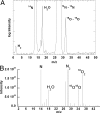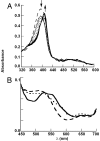Mechanism of and exquisite selectivity for O-O bond formation by the heme-dependent chlorite dismutase
- PMID: 18840691
- PMCID: PMC2572943
- DOI: 10.1073/pnas.0804279105
Mechanism of and exquisite selectivity for O-O bond formation by the heme-dependent chlorite dismutase
Abstract
Chlorite dismutase (Cld) is a heme b-dependent, O-O bond forming enzyme that transforms toxic chlorite (ClO(2)(-)) into innocuous chloride and molecular oxygen. The mechanism and specificity of the reaction with chlorite and alternate oxidants were investigated. Chlorite is the sole source of dioxygen as determined by oxygen-18 labeling studies. Based on ion chromatography and mass spectrometry results, Cld is highly specific for the dismutation of chlorite to chloride and dioxygen with no other side products. Cld does not use chlorite as an oxidant for oxygen atom transfer and halogenation reactions (using cosubstrates guaiacol, thioanisole, and monochlorodimedone, respectively). When peracetic acid or H(2)O(2) was used as an alternative oxidant, oxidation and oxygen atom transfer but not halogenation reactions occurred. Monitoring the reaction of Cld with peracetic acid by rapid-mixing UV-visible spectroscopy, the formation of the high valent compound I intermediate, [(Por(*+))Fe(IV) = O], was observed [k(1) = (1.28 +/- 0.04) x 10(6) M(-1) s(-1)]. Compound I readily decayed to form compound II in a manner that is independent of peracetic acid concentration (k(2) = 170 +/- 20 s(-1)). Both compound I and a compound II-associated tryptophanyl radical that resembles cytochrome c peroxidase (Ccp) compound I were observed by EPR under freeze-quench conditions. The data collectively suggest an O-O bond-forming mechanism involving generation of a compound I intermediate via oxygen atom transfer from chlorite, and subsequent recombination of the resulting hypochlorite and compound I.
Conflict of interest statement
The authors declare no conflict of interest.
Figures




References
-
- Coates JD, Achenbach LA. Microbial perchlorate reduction: Rocket-fuelled metabolism. Nat Rev Microbiol. 2004;2:569–580. - PubMed
-
- Xu JL, Song YU, Min BK, Steinberg L, Logan BE. Microbial degradation of perchlorate: Principles and applications. Environ Eng Sci. 2003;20:405–422.
-
- Betley TA, Wu Q, Van Voorhis T, Nocera DG. Electronic design criteria for O-O bond formation via metal-oxo complexes. Inorg Chem. 2008;47:1849–1861. - PubMed
Publication types
MeSH terms
Substances
Grants and funding
LinkOut - more resources
Full Text Sources
Other Literature Sources

